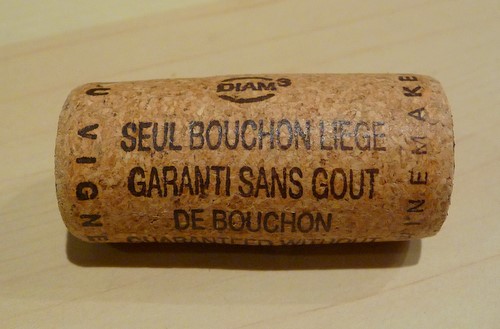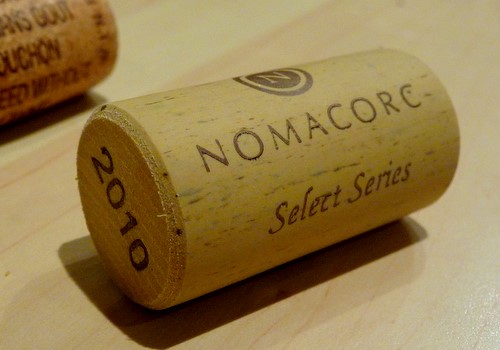Haven’t mentioned the juicy subject of wine bottle closures around here for a while.
I’m seeing more and more Diams – the technical cork that’s made from fragments of cork cleaned from any contamination by supercritical carbon dioxide. In a new move, I’ve encountered my first Diam (in a Bordeaux white) that guarantees on the cork to be taint free: ‘the only cork guaranteed without cork taint,’ it says, on the cork itself (above). Diam comes in a number of different oxygen transmission rates (OTRs), and is a really useful closure.
And Nomacorc, the world’s biggest manufacturer of synthetic corks, has just released a new product line. One of the problems with synthetic corks in the past has been their aesthetics. The new ‘Select’ series solves this: it’s a beautiful-looking closure, with a nice chamfer (the smoothing of the edges of the cylinder), a wood-grain effect on the sleeve, a very clever end-grain effect, and also end printing. It’s really attractive. As for now, the OTR is the same as the existing Nomacorc products (that is, reasonably high, which can be good for some wines and not good for others), but subsequent products in the select series will be taking the OTR rate down quite significantly.
10 Comments on Closures: Diam’s guarantee, and new from Nomacorc



Very interesting stuff. Is the OTR mainly determined by transmission through the “cork” or around the sides, due to imperfect fit?
I had a domaine leflaive chard (generic Bourg blank) the other day and it had a 4? Part plastic cork. A yellow centre, green outside, and then a clear plastic base, through to the yellow. Wondered what it was, and how good you consider it. The Dom leflaive PC had real cork though?
Jamie, is the Nomacorq guaranteed taint-free in the same way as DIAM?
Andrew, it depends. For synthetics, the oxygen transmission is through the body of the closure (plastic allows some diffusion of oxygen through it). For natural cork, the evidence seems to be that it is through the glass/cork interface.
Nick, both closures should be free of taint. There is the possibility that they could be contaminated post-manufacture, but this is a low risk, and zero if sensible precautions are taken. Nomacorc have a sensory lab that checks each batch of plastic raw material that comes in, because this is a potential source of taint (if the plastic had been contaminated prior to manufacture).
Does “guaranteed” mean they’ll replace the wine (or give cash to market value) if the wine is TCA-afflicted?
Spotted a Tim Adams video talking to an Irish journo about cork v screwcap, worth a watch. Seems the ship has sailed with Aussie winemakers who were so fed up cork taint.
I have had the misfortune on many many many occasions of opening a bottle of wine that would have been perfectly drinkable under cork or screwcap at 5 years of age, disgusting under Nomacork.. this is a cheap useless closure and you should call them on it. Most wines are meant to be consumed withing a year or 2 but I have opened some wines like a Los Vascos 2005 Cab that I know would have been fine if not for that inferior closure.also a bottle of JL: Colombo red Cotes du rhone. can’t we be honest enough to condemn a faulty product.
We have been using Diam closures since 2004 and have(after using a few million of them) yet to have a complaint or return. I honestly believe that these closures will be the future of the wine industry – over both natural cork and screwcap.
Jason. From my limited knowledge Nomacorc is the top dog in synthetic closure manufacture. You should see some of the synthetic closures on the market here in Italy, they are effectively plastic stoppers with little or no elasticity and consequential poor performance. I think the market is polarising between screwcaps and cork and the synthetics are having a pretty tough time. Would you agree Jamie?
I know they are the top dog, but they still are a terrible inferior product.